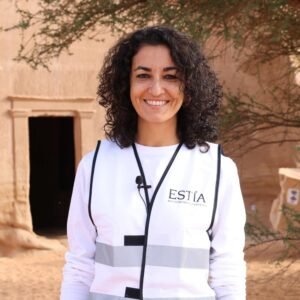Journey to AlUla
Milan, November 5th. It’s autumn, but only a few days ago, t-shirts gave way to heavier clothes. And they ended up in a suitcase, because there is a warm destination waiting for us: Hegra site in Saudi Arabia. We are a group of 5, all women, all restorers but with different ages and backgrounds.
Some of us meet today for the first time, thanks to the opportunity provided by Paolo Pecorelli and Nadia Cavallucci of Estia: a study project in collaboration with the Royal Commission for AlUla (RCU) on the Hegra site, a few kilometers from the city of AlUla. Here, the Nabataeans, a people of ancient Arabian merchants, carved in the sandstone, about two thousand years ago, more than a hundred tombs.
The journey from Milan to AlUla is quite challenging, but motivation helps us overcome fatigue. After landing in Jeddah, a private transfer takes us to our destination in about 7 hours. The road is straight, it cuts through the desert, but it’s full of bumps that keep us awake. We arrive at night at what will be our home for about six months.
A few hours of sleep are enough to recharge our batteries and go out. We pick up the rental car and head out to buy some groceries. In the months leading up to departure, Ylenia Rubino and Gregorio Pecorelli (site manager and project manager, respectively), along with Estia’s office, have meticulously prepared everything from Italy.
After settling into our home, we head to Hegra. Within 20 minutes, we reach the gate of this UNESCO heritage site since 2008.

A Study of Technique and Preservation
We show our ID cards to the guardians and we get it. There are no words, photos, or videos capable of describing the magnificence of this place: an endless expanse and massifs of sandstone with bizarre shapes that evoke childhood sand games.
And then suddenly, the eye falls on the tombs that the Nabataeans carved about 2000 years ago to give a dignified burial to their most illustrious dead. The Nabataeans, the same people of merchants who founded Petra in Jordan, another gem of craftsmanship.
The first days in the site are used to get to know all the tombs up-close, the execution technique, and their conservation status. Some of them are in excellent condition, as if they were made yesterday. Others, however, are almost unreadable, either because they have partially collapsed or because they have been eroded by rain and wind, or because they have been left incomplete. As for Tomb 46, visible on the upper part of the Jabal AlBanat massif, carved only in the upper part and then left unfinished. If completed, it would have been the largest of all. What a pity…

Essential Tools for Exploration
At the moment, our work here involves documenting everything we observe and record on a GIS system. There are thousands of data, impossible to manage without a digital platform. For this part of the work, the team of Vincenzo Sommella of ES Progetti e Sistemi and collaborators of Giuseppe Boselli of Geogrà, with whom we share the house, helps us remotely. They conduct surveys in the field, and soon, they will provide us with the first orthophoto planes we need for mapping.

Sharing Knowledge and Passion at Hegra
A few days ago, all the scientists and technicians involved in the Hegra Conservation Project came and stayed with us for 5 days. This team of respected professionals, led by Prof. Mauro Matteini, includes Prof. Fabio Fratini for the characterization of the constituent materials and the researchers Paola De Nuntiis and Loris Branzanti for environmental monitoring. The diagnostic investigations will be guided by the spin off of the University of Camerino A.R.T. & Co. S.r.l. (Giuseppe Di Girolami, Graziella Roselli, Antonella Potenza) and by the team of Mapei SpA (Davide Bandera, Daniele Sala, Andrea Perini).
Daniel Donati will oversee all concerning the communication of the activities that will be carried out in the coming months. For us restorers, it’s truly stimulating to test ourselves on the dissemination front: every day, when we are in front of the tombs, dozens of tourists, often Italians, approach us to know what we are doing. It’s evident that it’s not always a matter of simple curiosity but it is a real desire to understand more, helped by those who, like us, have the fortune to come into close contact with the material that constitutes the artwork.




